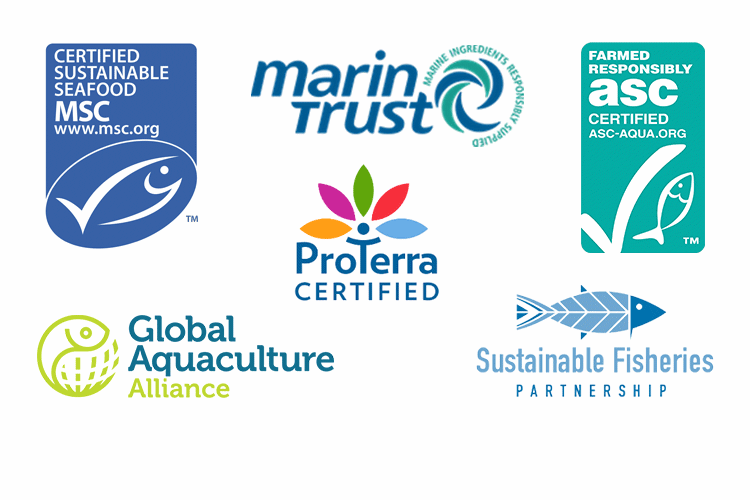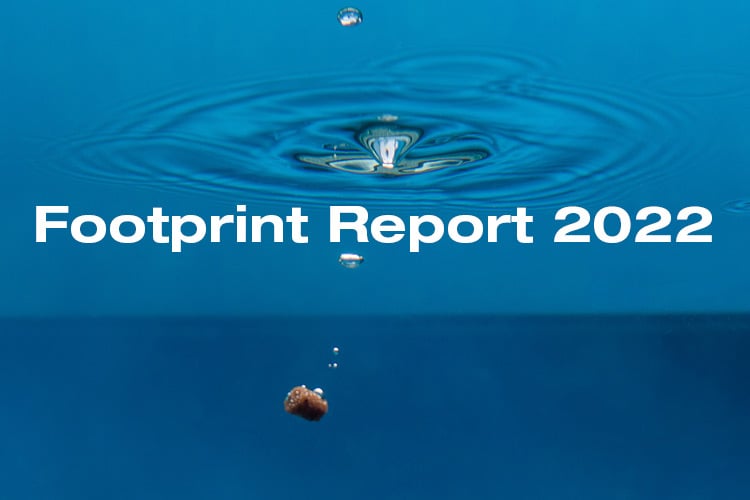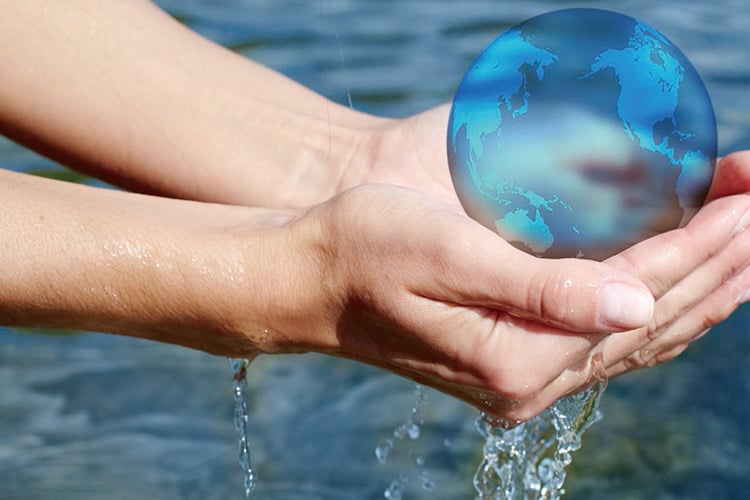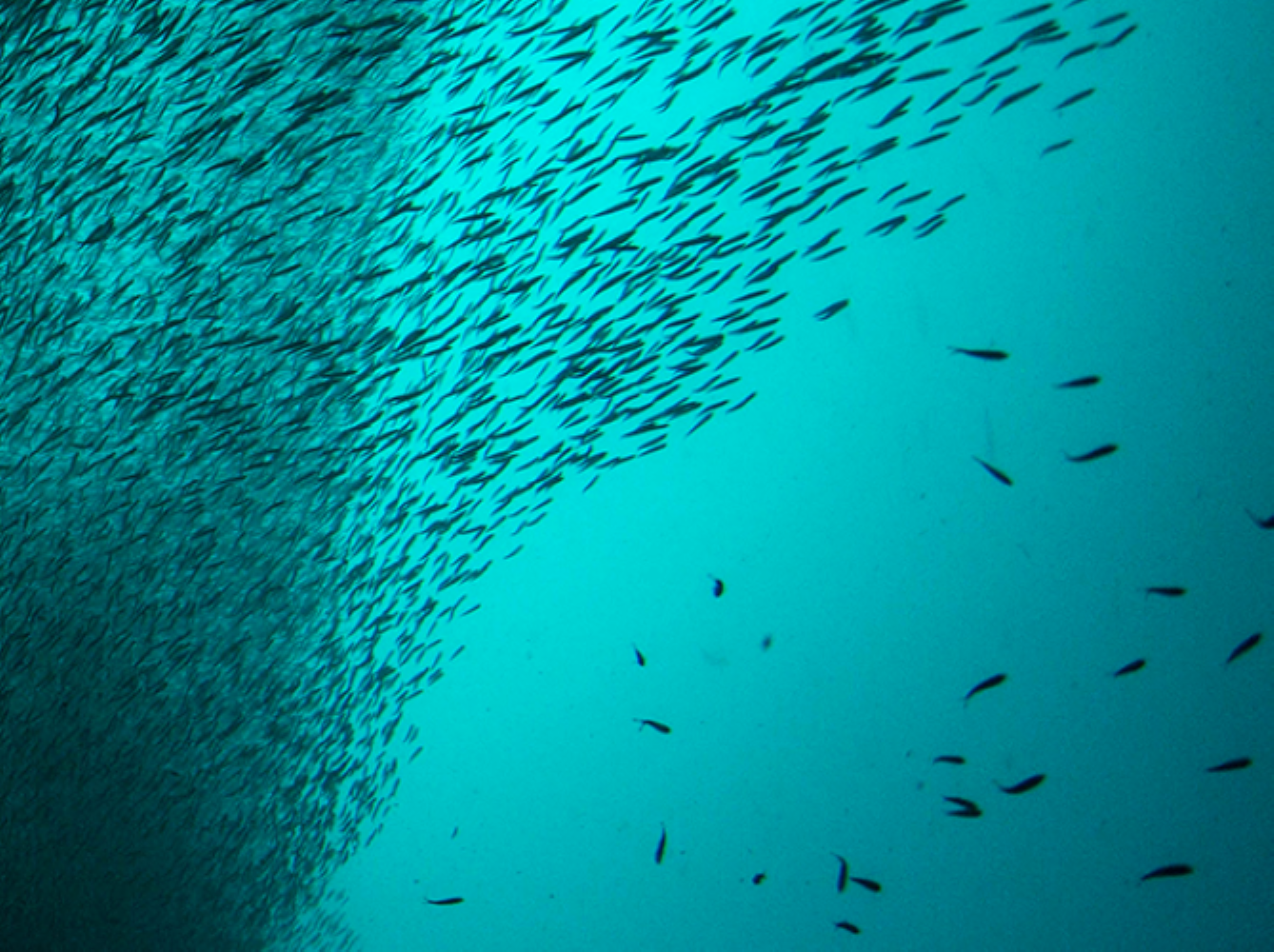
Use of marine raw materials 2022
We strive to balance the need to produce feed for healthy meals for human consumption with our goal to be an environmentally responsible producer. We do this by sourcing sustainable feed ingredients and a focus on reduced dependency on wild fish for feed.
In 2022 it took 0,59* kg wild fish to produce 1 kg of feed. 35,4 % of this fish meal and fish oil originated from trimmings — up from 25 % in 2021. Almost 98 % of these marine ingredients used in 2022 was certified or from a FIP. The rest (2,6 %) is mainly due to trimmings and legal by-catch.
* FIFO, according to: Jackson, A. 2009. Click here to scroll down to FFDRm and FFDRo data.
Certification status marine raw materials (fish oil and fish meal from both whole fish and trimmings)
| 2022 | 2021 | 2020 | |
| MSC approved | 34,4 % | 53,6 % | 64,3 % |
| MarinTrust | 51,0 % | 42,7 % | 31,7 % |
| FIP | 12,0 % | 2,2 % | 0,8 % |
| None* | 2,6 % | 1,6 % | 3,2 % |
| Total | 100 % | 100 % | 100 % |
* The number for "None" is mainly due to trimmings and legal by-catch.
Trimmings proportion in fish meal and fish oil
| 2022 | 2021 | 2020 | 2019 | 2018 | |
| Proportion fish meal from trimmings | 32,8 % | 20,5 % | 13,7 % | 21,7 % | 22,0 % |
| Proportion fish oil from trimmings | 39,3 % | 31,5 % | 16,6 % | 12,0 % | 26,0 % |
| Trimmings of marine raw materials (meal and oil combined) |
35,4 % | 25,0 % | 15,0 % | 16,8 % | 23,9 % |
Kg wild fish per kg feed, Forage Fish Dependency Ratio for feed and FIFO
| 2022 | 2021 | 2020 | 2019 | 2018 | |
| FFDR for fish meal per kg feed (FFDRm) | 0,46 | 0,43 | 0,44 | 0,35 | 0,42 |
| FFDR for fish oil per kg feed (FFDRo) | 1,04 | 1,09 | 1,39 | 1,52 | 1,24 |
| FIFO* | 0,59 | 0,57 | 0,63 | 0,59 | 0,60 |
*FIFO, according to: Jackson, A. 2009.
Below is more granulated data for certification status, FFDR and the origin of fish meal and oil respectively used in Skretting Norway's feed.
Certification status of marine raw materials
Skretting Norway only buys marine raw materials from whole fish that are either certified (MSC or MarinTrust) or subject to a Fishery Improvement Project (FIP).
Almost 98 % of the fish meal and fish oil used in 2022 was certified or from a FIP. The rest is mainly due to trimmings and legal by-catch.
Source of marine raw materials
Wild fish harvested from the ocean and processed into fish meal and fish oil are ingredients in fish feeds. Small pelagic fisheries are used in the fish meal and fish oil industry, but in some regions they are also important for direct human consumption. Also known as forage species, these are small, short-lived species that occupy a low trophic level (LTL) in the ecosystem. Due to their specific population biology and dynamics, these species are frequently resilient to fishing pressure if catches are well managed, but overfishing is always a possibility without effective controls. Through our Roadmap 2025, we strive to ensure that marine-based feed ingredients come from sustainable sources in the short- and long-term. The requirements aim to align industry incentives to support processes that will lead to improved fisheries management.
Fish meal
Fish meal from whole fish certification status
| 2022 | 2021 | 2020 | |
| MSC approved | 25,1 % | 59,3 % | 85,0 % |
| MarinTrust | 55,9 % | 35,5 % | 14,0 % |
| FIP | 17,2 % | 4,2 % | - |
| None | 1,7 % | 0,9 % | 1,0 % |
| Total | 100 % | 100 % | 100 % |
Fish meal from trimmings certification status
| 2022 | 2021 | 2020 | |
| MSC approved | 31,0 % | 56,0 % | 70,0 % |
| MarinTrust | 59,7 % | 37,9 % | 23,0 % |
| FIP | 4,6 % | - | - |
| None | 4,7 % | 6,2 % | 7,0 % |
| Total | 100 % | 100 % | 100 % |
* In 2022 32,84 % of the fish meal came from trimmings. The rest, 67,16 %, came from whole fish. Click here for more information about the origin and use of whole fish and trimmings.
Fish oil
Fish oil from whole fish certification status
| 2022 | 2021 | 2020 | |
| MSC approved | 48,7 % | 43,9 % | 41,0 % |
| MarinTrust | 32,0 % | 54,5 % | 54,0 % |
| FIP | 17,0 % | 0,8 % | 2,0 % |
| None | 3,3 % | 0,8 % | 3,0 % |
| Total | 100 % | 100 % | 100 % |
Fish oil from trimmings certification status
| 2022 | 2021 | 2020 | |
| MSC approved | 41,1 % | 54,6 % | 53,0 % |
| MarinTrust | 57,8 % | 43,6 % | 36,0 % |
| FIP | - | - | - |
| None | 1,0 % | 1,8 % | 11,0 % |
| Total | 100 % | 100 % | 100 % |
* In 2022 39,35 % of the fish oil came from trimmings. The rest, 60,65 %, came from whole fish. Click here for more information about the origin and use of whole fish and trimmings.
Use of wild fish for feed
Wild fish harvested from the ocean and processed into fish meal and fish oil are ingredients in fish feeds, and the Norwegian aquaculture industry has significantly reduced the inclusion rates of fish meal and fish oil from forage fish in fish feeds during the past two decades.
Fish meal and fish oil are both limited resources that are shared across a range of users with increasing demands including direct human consumption, aquaculture and pork and poultry production. We promote an efficient use of these resources, producing increasing amounts of farmed fish from a given input of fish meal and fish oil.
With the knowledge that we have at Skretting, salmon grower feeds can essentially require zero marine ingredients. This is possible due to 30 years of R&D at Skretting Aquaculture Innovation.
We will regularly update the industry with our use of wild fish used to produce 1 kg of feed, based on the average, weighted raw material composition. The use of wild fish is expressed as the Forage Fish Dependency Ratio (FFDR). It will be calculated based on the use of fish meal and fish oil.
FISH MEAL FFDR: Use of wild fish in feed, Forage Fish Dependency Ratio for fish meal
| 2022 | 2021 | 2020 | 2019 | 2018 | Unit | |
| PROPORTION FISH MEAL FROM TRIMMINGS | 32,8 | 20,5 | 13,7 | 21,7 | 22,0 | % of total fish meal |
| TOTAL FISH MEAL | 16,6 | 13,1 | 11,7 | 10,3 | 12,4 | % of total feed |
| MINUS FISH MEAL FROM TRIMMINGS | 5,4 | 2,7 | 1,6 | 2,2 | 2,7 | % of total feed |
| FISH MEAL FROM WHOLE FISH | 11,1 | 10,4 | 10,1 | 8,0 | 9,7 | % of total feed |
| FISH MEAL FROM WHOLE FISH PER KG FEED | 111 | 104 | 101 | 80 | 97 | grams |
| FISH MEAL YIELD, STANDARD NUMBER | 24,0 | 24,0 | 23,0 | 23,0 | 23,0 | % yield of fish meal* |
| FFDRm PER KG FEED | 0,46 | 0,43 | 0,44 | 0,35 | 0,42 | kg wild fish per kg feed |
FISH OIL FFDR: Use of wild fish in feed, Forage Fish Dependency Ratio for fish oil
| 2022 | 2021 | 2020 | 2019 | 2018 | Unit | |
| PROPORTION FISH OIL FROM TRIMMINGS | 39,3 | 31,5 | 16,6 | 12,0 | 26,0 | % of total fish meal |
| TOTAL FISH OIL | 11,0 | 10,2 | 10,0 | 10,4 | 10,9 | % of total feed |
| MINUS FISH OIL FROM TRIMMINGS | 4,3 | 3,2 | 1,7 | 1,2 | 2,8 | % of total feed |
| FISH OIL FROM WHOLE FISH | 6,7 | 7,0 | 8,3 | 9,1 | 8,1 | % of total feed |
| FISH OIL FROM WHOLE FISH PER KG FEED | 67 | 70 | 83 | 91 | 81 | grams |
| FISH OIL YIELD adjusted for geographical origin according to the ASC standard | 6,4 | 6,4 | 6,0 | 6,0 | 6,5 | % yield of fish oil* |
| FFDRo per kg feed | 1,04 | 1,09 | 1,39 | 1,52 | 1,24 | kg wild fish per kg feed |
* The yield refers to the amount of fish meal and fish oil one in average will get from processing 1 kg of wild fish, and are calculated according to the instructions given in the ASC salmon standard document v1.4 - February 2023. Typical figures from the industry refers to that one in average get 240 grams (24%) fish meal from processing 1 kg of wild fish and in average 50 grams to 70 grams of fish oil (depending on origin) from processing 1 kg of wild fish. The yield of fish oil will be variable – depending on species and season of the year.
Source and origin of marine raw materials
Small pelagic fisheries are used in the fish meal and fish oil industry, but in some regions they are also important for direct human consumption. Also known as forage species, these are small, short-lived species that occupy a low trophic level (LTL) in the ecosystem. Due to their specific population biology and dynamics, these species are frequently resilient to fishing pressure if catches are well managed, but overfishing is always a possibility without effective controls. Through our Roadmap 2025, we strive to ensure that marine-based feed ingredients come from sustainable sources in the short- and long-term. The requirements aim to align industry incentives to support processes that will lead to improved fisheries management.
All fish meal and fish oil we use from whole fish must originate from certified (MSC or MarinTrust) fisheries or fisheries subjected to a Fishery Improvement Project (FIP).
Origin of fish meal and fish oil from whole fish 2022
| Species | Latin name | Fish meal | Fish oil | Country of origin |
| Blue whiting | Micromesistius poutassou | 13,81 % | 5,81 % | Denmark, Iceland, Norway |
| Boarfish | Capros aper | 3,03 % | - | Denmark, Ireland, Norway |
| Capelin | Mallotus villosus | 6,79 % | 10,52 % | Denmark, Iceland, Norway |
| Gulf Menhaden | Brevoortia patronus | - | 3,62 % | USA |
| Herring | Clupea harengus | 6,76 % | 8,84 % | Denmark, Iceland, Norway |
| Mackerel | Scomber scombrus | 0,18 % | 0,32 % | Chile, Denmark, Norway |
| Norway pout | Trisopterus esmarkii | 2,06 % | 1,31 % | Denmark, Norway |
| Pacific Anchoveta | Cetengraulis mysticetus | - | 1,49 % | Panama |
| Peruvian anchoveta | Engraulis ringens | 20,99 % | 5,65 % | Chile, Peru |
| Sandeel | Ammodytes marinus | 5,07 % | 6,02 % | Denmark, Norway |
| Sardine | Sardinella Sp | - | 2,90 % | Chile, Mauritania |
| Sprat | Sprattus sprattus | 7,57 % | 13,66 % | Denmark, Norway |
| Other | 0,88 % | 0,51 % | Chile, Denmark, Iceland, Norway | |
| Total | 67,14 % | 60,65 % |
Origin of fish meal and fish oil from trimmings 2022
| Species | Latin name | Fish meal | Fish oil | Country of origin |
| Blue whiting | Micromesistius poutassou | 1,51 % | 0,02 % | Ireland, Norway |
| Boarfish | 0,04 % | - | Norway | |
| Capelin | Mallotus villosus | 6,04 % | 4,24 % | Iceland, Norway |
| Cod | Gadus morhua | 1,51 % | 0,29 % | Denmark, Ireland, Norway |
| Herring | Clupea harengus | 15,35 % | 23,80 % | Denmark, Iceland, Norway |
| Mackerel | Scomber scombrus | 7,20 % | 8,88 % | Denmark, Iceland, Ireland, Norway |
| Plaice | Pleuronectes platessa | 0,17 % | 0,05 % | Denmark |
| Saithe | Pollachius virens | 0,05 % | 0,02 % | Norway |
| Sandeel | Ammodytes marinus | - | 1,51 % | Denmark |
| Sprat | Sprattus sprattus | 0,35 % | 0,29 % | Denmark, Ireland, Norway |
| Other | 0,60 % | 0,25 % | Denmark, Ireland, Norway | |
| Total | 32,82 % | 39,35 % |
Origin of fish meal and fish oil from farmed fish
| Species | Latin name | Fish meal | Fish oil | Country of origin |
| Farmed salmon* | Salmo salar | - | 98,69 % | Norway |
| Farmed trout* | Oncorhynchus mykiss | - | 1,31 % | Norway |
* Fish oil from farmed fish is only included in customer specific feeds
Changes to this article
This article was updated 06 May 2024, where the initial numbers for "Trimmings of marine raw materials (meal and oil combined)" for the respective years 2018, 2019 and 2020 were wrong. It said that it was 19,9 % for 2018, 15,1 % for 2019 and 15,2 % for 2020. The correct numbers are 23,9 % for 2018, 16,8 % for 2019 and 15,0 % for 2020.





